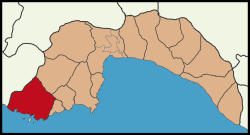Kaş
| Kaş | |
|---|---|
| Town | |

Part of the town seen from the sea
|
|
 Location of Kaş within Antalya Province. |
|
| Location of Kaş within Antalya Province. | |
| Coordinates: 36°12′00″N 29°38′30″E / 36.20000°N 29.64167°ECoordinates: 36°12′00″N 29°38′30″E / 36.20000°N 29.64167°E | |
| Country |
|
| Region | Mediterranean |
| Province | Antalya |
| Government | |
| • Mayor | Abdullah Gültekin (CHP) |
| Area | |
| • District | 1,866.80 km2 (720.78 sq mi) |
| Elevation | 0- 700 m (−2,300 ft) |
| Population (2012) | |
| • Urban | 7,258 |
| • District | 53,633 |
| • District density | 29/km2 (74/sq mi) |
| Time zone | EET (UTC+2) |
| • Summer (DST) | EEST (UTC+3) |
| Postal code | 07x xx |
| Area code(s) | (0090)+ 242 |
| Licence plate | 07 |
| Website | www.kas.bel.tr |
Kaş (pronounced 'Kash') is a small fishing, diving, yachting and tourist town, and a district of Antalya Province of Turkey, 168 km west of the city of Antalya. As a tourist resort, it is relatively unspoilt.
The town of Kaş is on a hill running down to the Turquoise Coast of southwestern Turkey. The district has a typical Mediterranean climate of hot, dry summers and warm, wet winters, which allows the growth of oranges, lemons and bananas. The lowland areas are also planted with cut flowers and a variety of fruits and vegetables, many are grown all year round under glass. The hillsides produce honey, and almonds, while at high altitudes there are extensive pine forests. The weather is drier at high altitudes. Although agriculture is still important, tourism is the main source of income in the district, which has many hotels and guest houses.
About 6 km (4 mi) offshore from Kaş is the Greek islet of Kastelórizo (in Turkish Meis Adası) served by a Turkish ferry daily with the option of same day returns.
Although the Teke peninsula has been occupied since the stone age it seems Kaş was founded by the Lycians, and its name in Lycian language was Habesos or Habesa. It was a member of the Lycian League, and its importance during this time is confirmed by the presence of one of the richest Lycian necropoleis.
In the Hellenistic period and under the Roman Empire it served as the port of Phellus. For information on its history at that time and on its archaeological remains, see the article on Antiphellus, the name by which it was known at that time.
The town suffered because of Arab incursions, then was annexed (under the name of Andifli) to the Anatolian Sultanate of Rum, led by the Seljuks. After the demise of the Seljuks, it came under the Ottomans.
...
Wikipedia

